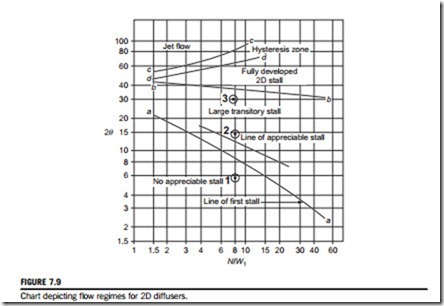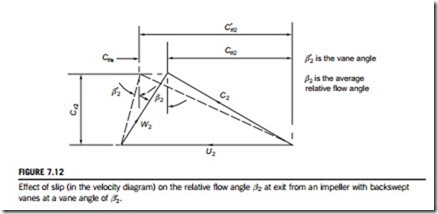Design of a centrifugal compressor inlet
To obtain high efficiencies from high-pressure ratio compressors, it is necessary to limit the relative Mach number at the eye. In the following paragraphs, two analyses are given, the first for an axial flow at inlet, α1 5 0o, and the second when prewhirl vanes are used and α1 . 0o. The analyses are applied to the shroud radius rs1 at the impeller eye.
EXAMPLE 7.2
The inlet of a centrifugal compressor is fitted with free-vortex guide vanes to provide a positive prewhirl of 30o at the shroud. The inlet hub-shroud radius ratio is 0.4 and a requirement of the
design is that the relative inlet Mach number, M1,rel, does not exceed 0.9. The air mass flow is 1 kg/s, the stagnation pressure and temperature are 101.3 kPa and 288 K. For air, take R 5 287 J/ (kg K) and γ 5 1.4.
Assuming optimum conditions at the shroud, determine
a. the rotational speed of the impeller;
b. the inlet static density downstream of the guide vanes at the shroud and the axial velocity;
c. the inducer tip diameter and velocity.
Solution
Some remarks on the use of prewhirl vanes at entry to the impeller Introducing positive prewhirl (i.e., in the direction of impeller rotation) can give a significant reduction of w1 and the inlet Mach number M1,rel but, as can be seen from the Euler pump equation, Eq. (1.18b), it reduces the specific work done on the gas. Thus, it is necessary to increase the blade tip speed to maintain the same level of impeller pressure ratio as was obtained without prewhirl.
Prewhirl is obtained by fitting guide vanes upstream of the impeller. One arrangement for doing this is shown in Figure 7.10(a). The velocity triangles, Figure 7.10(b) and (c), suggest how the guide vanes reduce the relative inlet velocity. Guide vanes are designed to produce either a free vortex or some form of forced-vortex velocity distribution. In Chapter 6, it was shown that for a free-vortex flow (rcθ 5 constant) the axial velocity, cx, is constant (in the ideal flow). It was shown by Wallace, Whitfield, and Atkey (1975) that the use of free-vortex prewhirl vanes leads to a sig- nificant increase in incidence angle with low inducer radius ratios. The use of some forced-vortex velocity distribution does alleviate this problem. Whitfield and Baines (1990) have reviewed some of the effects resulting from the adoption of various forms of a generalized forced-vortex,
Figure 7.11(a) shows (for a particular case in which αs1 5 30o, βs1 5 60o) the effect of prewhirl on the variation of the incidence angle, i 5 β1 2 β0 with radius ratio, r/rs1, for several whirl distributions. Figure 7.11(b) shows the corresponding variations of the absolute flow angle, α1. It is apparent that a high degree of prewhirl vane twist is required for either a free-vortex design or the quadratic (n 5 2) design. The advantage of the quadratic design is the low variation of incidence with radius, where it is evident that the free-vortex design produces a wide variation of incidence.
Wallace et al. (1975) adopted the simple untwisted blade shape (n 5 0), which proved to be a reasonable compromise.
Related posts:
Incoming search terms:
- prewhirl in centrifugal pump
- centrifugal fan with backward curved has an impeller outside diameter of 520mm and is driven at 1410rev/min the radial air velocity is 10m/s and the blade outlet angle is 35degrees assume the whirl velocity at the impeller inlet to be zero the air mass de
- free vortex centrifugal compressor
- is prewhirl required in centrifugal pump







